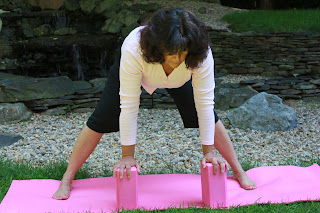Purpose of Twists
Twists can boost energy when feeling tired or fatigued. When we twist, we literally squeeze tension and toxins out from the body. In twisting poses, our muscles have an opportunity to squeeze and relax, and once finished, the area that released will then experience a rush of blood and nutrients.
Benefits
Stretches pectoralis muscle
Post surgical benefits of reducing fibrous adhesions and scar tissue
Opens shoulder joint and improves flexibility
Increases circulation and blood flow in chest
Strong hip opener and deep twist in inner core.
Lengthen and strengthen side body and increases vitality
Massages lower abdominal organs and glands
Expands ribs for deeper breathing
Contraindications
Lumbar or sacral injuries
Shoulder and rotator cuff injuries
Instructions____________________________________________________________Instructions
- Begin in a wide stance about 3 feet apart with feet parallel (make sure the leg remains anchored).
- EXHALE, and bring arms forward, placing hands directly underneath shoulders with head in its natural alignment )use a bolster or yoga blocks so there isn’t a collapse in the front of the body).
- INHALE, extend right arm out and then overhead (follow arm with eyes).
- EXHALE, lower arm and head back to center.
- INHALE, and repeat left side(make sure your head doesn’t collapse).
- EXHALE, return to neutral.
- Let your legs and arms support the extension of the spine.
- Continue for 5 or more twist, then sustain into the pose on left and right side t on left side.
Twisting Yoga Poses E-book
Breast Cancer Yoga released a “Healthy & Hopeful Lifestyle” E-book Series that contain specific restorative yoga poses that assist in breast cancer post - surgical recovery, fatigue and lymphedema management. Also included is a breathing exercise which is an essential tool for reduction of stress, anxiety and depression. Complementary Therapies are suggested to further enhance healing.
By Diana Ross E-RYT 500










